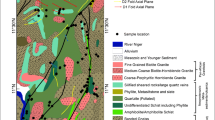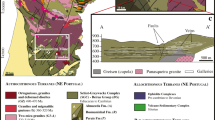Abstract
The physico-chemical exchanges between hydrothermal fluids and the host rock are usually controlled by elemental interaction effects. A criterion-based backward elimination approach applies the iterative regression analysis and analysis of variance to investigate the geochemical features of the polymetallic Glojeh (Au–Ag–Cu–Pb–Zn) deposit in NW Iran. A statistical definition of the elemental interaction effects (X2i−j, Xi × Xj) could elucidate the relationship between variables and the performance of a full quadratic polynomial model (QPM). The model optimization procedure was carried out by the removal of insignificant predictors (P value 95% CL) based on R2(pred.) criterion. In order to straighten the convergent trend with R2 and R2(adj.), R2(pred.) gradually increased from 0% to 77.8% by 15-steps optimization. The miniature-scale geochemical changes indicate double ordinal Au (Ag, Pb) and Au (Ag, Zn) interactions within the vein and host rock, in QPM. Results show that the Au (Pb–Zn) commonly presents ordinal effect at the vein and disordinal interaction at the host rock. This ordinal–disordinal interaction revealed that elements Pb and Zn have similar geochemical features during mineralization. In addition, Akima’s polynomial contour map confirms the results from Pb–Zn interaction effects by dependency tracing between Au–Pb–Zn at different populations. However, it is noteworthy that Pb and Zn occur together in the second phase of Pb–Zn–Cu ± (Ag ± Cd) sulfide mineralization at Glojeh, which implies intergrowth and interaction of Pb–Zn on Au concentration. Pb and Zn demonstrate relatively high mobility and are generally concentrated in the near surface zones. Nb is an immobile element during alteration and high content Hg zone is mainly restricted to narrow stripes above ore vein and veinlets.

After Darabi-Golestan and Hezarkhani (2016)














Similar content being viewed by others
References
Akima H (1970) A new method of interpolation and smooth curve fitting based on local procedures. J ACM (JACM) 17:589–602
Ali K, Witter D, Ortiz J (2014) Application of empirical and semi-analytical algorithms to MERIS data for estimating chlorophyll a in Case 2 waters of Lake Erie. Environ Earth Sci 71:4209–4220
Azadi TE, Almasganj F (2009) Using backward elimination with a new model order reduction algorithm to select best double mixture model for document clustering. Expert Syst Appl 36:10485–10493
Bahajroy M, Taki S (2014) Study of the mineralization potential of the intrusives around Valis (Tarom-Iran). Earth Sci Res J 18:123–129
Barbin DF, Sobottka RP, Risso WE, Zucareli C, Hirooka EY (2016) Influence of plant densities and fertilization on maize grains by near-infrared spectroscopy. Spectrosc Lett 49:73–79
Bendezú R, Fontboté L (2009) Cordilleran epithermal Cu–Zn–Pb–(Au–Ag) mineralization in the Colquijirca district, central Peru: deposit-scale mineralogical patterns. Econ Geol 104:905–944
Borah P, Singh MK, Mahapatra S (2015) Estimation of degree-days for different climatic zones of North-East India. Sustain Cities Soc 14:70–81
Briand G, Hill RC (2013) Teaching basic econometric concepts using Monte Carlo simulations in Excel International Review of Economics. Education 12:60–79
Chun Y, Griffith DA, Lee M, Sinha P (2016) Eigenvector selection with stepwise regression techniques to construct eigenvector spatial filters. J Geogr Syst 18:67–85
Cordell HJ, Clayton DG (2002) A unified stepwise regression procedure for evaluating the relative effects of polymorphisms within a gene using case/control or family data: application to HLA in type 1 diabetes. Am J Hum Genetics 70:124–141
Correll RL (2001) The use of composite sampling in contaminated sites—a case study. Environ Ecol Stat 8:185–200
Coruh S, Elevli S (2014) Optimization of malachite green dye removal by sepiolite clay using a central composite design. Global NEST Journal 16:339–347
Darabi-Golestan F, Hezarkhani A (2016) High precision analysis modeling by backward elimination with attitude on interaction effects on Au (Ag)-polymetallic mineralization of Glojeh. Iran J Afr Earth Sci 124:505–516
Darabi-Golestan F, Hezarkhani A (2018a) Evaluation of elemental mineralization rank using fractal and multivariate techniques and improving the performance by log-ratio transformation. J Geochem Explor 189:11–24
Darabi-Golestan F, Hezarkhani A (2018b) Intensification of the polymetallic vein exploration by multivariate analysis and staged LINEST function at Glojeh deposit. NW Iran J Afr Earth Sci 147:190–198
Darabi-Golestan F, Hezarkhani A (2018c) Quadratic investigation of geochemical distribution by backward elimination approach at Glojeh epithermal Au (Ag)-polymetallic mineralization. NW Iran J Central South Univ 25:342–356
Darabi-Golestan F, Hezarkhani A (2018d) R-and Q-mode multivariate analysis to sense spatial mineralization rather than uni-elemental fractal modeling in polymetallic vein deposits. Geosyst Eng 21:226–235
Darabi-Golestan F, Hezarkhani A, Seifpanahi-Shabani K (2015) Application of correspondence analysis and fractal geometry to detect anomalous elements (As, Cd, Pb) in soil and determine anomaly area in 1:100000 Khosf. New Find Appl Geol 9:9–17
DeCoursey W (2003) Statistics and probability for engineering applications. Elsevier, Amsterdam
Doove L, Van Buuren S, Dusseldorp E (2014) Recursive partitioning for missing data imputation in the presence of interaction effects. Comput Stat Data Anal 72:92–104
Ettler V, Piantone P, Touray J-C (2003) Mineralogical control on inorganic contaminant mobility in leachate from lead–zinc metallurgical slag: experimental approach and long-term assessment. Mineral Mag 67:1269–1283
Figueiredo MAT, Jain AK (2002) Unsupervised learning of finite mixture models. IEEE Trans Pattern Anal Mach Intell 24:381–396
Fried J, Zietz S (1973) Curve fitting by Spline and Akima methods: possibility of interpolation error and its suppression. Phys Med Biol 18:550
Garson G (2012) Multiple regression (statistical associates blue book series) Asheboro. Statistical Associates Publishers, Asheboro
Ghorbani M (2013) The economic geology of Iran: mineral deposits and natural resources. Springer, Berlin
Granian H, Tabatabaei SH, Asadi HH, Carranza EJM (2015) Multivariate regression analysis of lithogeochemical data to model subsurface mineralization: a case study from the Sari Gunay epithermal gold deposit. NW Iran J Geochem Explor 148:249–258
Gupta SD, MacKenzie M, Quideau S (2015) Using spatial ecology to examine above and belowground interactions on a reclaimed aspen stand in northern Alberta. Geoderma 259:12–22
Gustavsson N, Loukola-Ruskeeniemi K, Tenhola M (2012) Evaluation of geochemical background levels around sulfide mines—a new statistical procedure with beanplots. Appl Geochem 27:240–249
Hagemann SG, Lüders V (2003) PTX conditions of hydrothermal fluids and precipitation mechanism of stibnite-gold mineralization at the Wiluna lode-gold deposits. Western Australia: conventional and infrared microthermometric constraints. Miner Depos 38:936–952
Hasanien HM, Abd-Rabou AS, Sakr SM (2010) Design optimization of transverse flux linear motor for weight reduction and performance improvement using response surface methodology and genetic algorithms. IEEE Trans Energy Convers 25:598–605
Heinrich CA (2007) Fluid–fluid interactions in magmatic-hydrothermal ore formation. Rev Mineral Geochem 65:363–387
Hill T, Lewicki P, Lewicki P (2006) Statistics: methods and applications: a comprehensive reference for science, industry, and data mining. StatSoft Inc, Tulsa
Hoang AH, Nguyen TT (2016) Identification of spatial distribution of geochemical anomalies based on GIS and CA fractal model—a case study of Jiurui copper mining area. J Geosci Geomat 4:36–41
Inomata Y, Aoyama M, Tsubono T, Tsumune D, Hirose K (2016) Spatial and temporal distributions of 134 Cs and 137 Cs derived from the TEPCO Fukushima Daiichi Nuclear Power Plant accident in the North Pacific Ocean by using optimal interpolation analysis. Environ Sci Process Impacts 18:126–136
Kelley DL, Kelley KD, Coker WB, Caughlin B, Doherty ME (2006) Beyond the obvious limits of ore deposits: the use of mineralogical, geochemical, and biological features for the remote detection of mineralization. Econ Geol 101:729–752
Larose DT (2006) Data mining methods and models. Wiley, New York
Li S, Zhao Z, Miaomiao X, Wang Y (2010) Investigating spatial non-stationary and scale-dependent relationships between urban surface temperature and environmental factors using geographically weighted regression. Environ Model Softw 25:1789–1800
Li H, Yonezu K, Watanabe K, Tindell T (2017) Fluid origin and migration of the Huangshaping W-Mo polymetallic deposit, South China: geochemistry and 40Ar/39Ar geochronology of hydrothermal K-feldspars. Ore Geol Rev 86:117–129
Lima A (2008) Evaluation of geochemical background at regional and local scales by fractal filtering technique: case studies in selected Italian areas Environmental. Geochemistry 27:135–152
Mao J, Zhang J, Pirajno F, Ishiyama D, Su H, Guo C, Chen Y (2011) Porphyry Cu–Au–Mo–epithermal Ag–Pb–Zn–distal hydrothermal Au deposits in the Dexing area, Jiangxi province, East China—a linked ore system. Ore Geol Rev 43:203–216
Matysek P, Sinclair A (1983) Statistical evaluation of duplicate samples, regional geochemical surveys 92H, 921 and 92J. Br Columbia Geol Fieldwork 5:1984–1991
Mehrabi B, Siani MG, Azizi H (2014) The genesis of the epithermal gold mineralization at North Glojeh veins. NW Iran IJSAR 15:479–497
Mehrabi B, Siani MG, Goldfarb R, Azizi H, Ganerod M, Marsh EE (2016) Mineral assemblages, fluid evolution, and genesis of polymetallic epithermal veins, Glojeh district, NW Iran. Ore Geol Rev 78:41–57
Menard S (2000) Coefficients of determination for multiple logistic regression analysis. Am Stat 54:17–24
Montgomery DC (2017) Design and analysis of experiments. Wiley, New York
Mousavi J, Parvini M (2016) A sensitivity analysis of parameters affecting the hydrogen release and dispersion using ANOVA method. Int J Hydrogen Energy 41:5188–5201
Myers RH, Montgomery DC, Anderson-Cook CM (2016) Response surface methodology: process and product optimization using designed experiments. Wiley, New York
Naprstek T, Smith R (2016) A new method for aeromagnetic data interpolation with a focus on linear features. In: SEG Technical Program Expanded Abstracts 2016. Society of Exploration Geophysicists, pp 2134–2138
Pasandideh SHR, Niaki STA, Far MH (2014) Optimization of vendor managed inventory of multiproduct EPQ model with multiple constraints using genetic algorithm. Int J Adv Manuf Technol 71:365–376
Patki AA, Thiagarajan G, Dasgupta U (2015) Asynchronous to synchronous sampling using Akima algorithm. Google Patents
Puri AB, Banerjee S (2013) Multiple-response optimisation of electrochemical grinding characteristics through response surface methodology. Int J Adv Manuf Technol 64(5–8):715–725
Remenyi D, Onofrei G, English J (2011) An introduction to statistics using Microsoft Excel. In: Academic Conferences Limited
Samal AR, Mohanty MK, Fifarek RH (2008) Backward elimination procedure for a predictive model of gold concentration. J Geochem Explor 97:69–82
Siani MG, Mehrabi B, Azizi H, Wilkinson CM, Ganerød M (2015) Geochemistry and geochronology of the volcano-plutonic rocks associated with the Glojeh epithermal gold mineralization, NW Iran. Open Geosciences 7:2391–5447
Steefel CI, Maher K (2009) Fluid–rock interaction: a reactive transport approach. Rev Mineral Geochem 70:485–532
Székely GJ, Rizzo ML (2013) The distance correlation t-test of independence in high dimension. J Multivar Anal 117:193–213
Wang M, Wright J, Brownlee A, Buswell R (2016) A comparison of approaches to stepwise regression on variables sensitivities in building simulation and analysis. Energy Build 127:313–326
Xiao F, Chen J, Zhang Z, Wang C, Wu G, Agterberg FP (2012) Singularity mapping and spatially weighted principal component analysis to identify geochemical anomalies associated with Ag and Pb–Zn polymetallic mineralization in Northwest Zhejiang, China. J Geochem Explor 122:90–100
Xiao F, Chen JG, Hou WS, Wang ZH (2017) Identification and extraction of Ag–Au mineralization associated geochemical anomaly in Pangxitong district, southern part of the Qinzhou–Hangzhou Metallogenic Belt. China Acta Petrol Sin 33(3):779–790
Xiao F, Chen J, Hou W, Wang Z, Zhou Y, Erten O (2018) A spatially weighted singularity mapping method applied to identify epithermal Ag and Pb–Zn polymetallic mineralization associated geochemical anomaly in Northwest Zhejiang, China. J Geochem Explor 189:122–137
Yadav V, Mueller KL, Michalak AM (2013) A backward elimination discrete optimization algorithm for model selection in spatio-temporal regression models. Environ Modell Softw 42:88–98
Yousefi M, Kamkar-Rouhani A, Carranza EJM (2014) Application of staged factor analysis and logistic function to create a fuzzy stream sediment geochemical evidence layer for mineral prospectivity mapping. Geochem Explor Environ Anal 14:45–58
Zhao T, Shi Y, Lin X, Duan J, Sun P, Zhang J (2014) Surface roughness prediction and parameters optimization in grinding and polishing process for IBR of aero-engine. Int J Adv Manuf Technol 74:653–663
Zuo R, Xia Q, Wang H (2013) Compositional data analysis in the study of integrated geochemical anomalies associated with mineralization. Appl Geochem 28:202–211
Acknowledgements
The authors are hugely thankful to Ms. Shima Allahyari for her encouragement and valuable help.
Author information
Authors and Affiliations
Corresponding author
Rights and permissions
About this article
Cite this article
Darabi-Golestan, F., Hezarkhani, A. Discrimination geochemical interaction effects on mineralization at the polymetallic Glojeh deposit, NW Iran by interative backward quadratic modeling. Acta Geochim 39, 236–254 (2020). https://doi.org/10.1007/s11631-019-00343-z
Received:
Revised:
Accepted:
Published:
Issue Date:
DOI: https://doi.org/10.1007/s11631-019-00343-z




